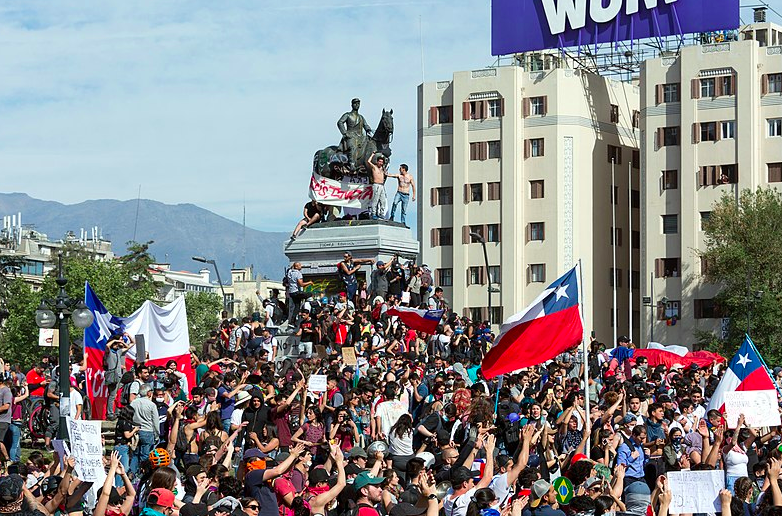I had a hard time figuring out how to spin this until I came across a video from the New York Times the other night. It talked about how the police are mutilating protesters in Chile by blinding them with rubber bullets. The reporter was speaking to a doctor who was working the ocular trauma unit of a Santiago hospital, and she said that the tiny balls generate such tremendous impact that “the eyeball just opens up like a flower.” Someone else compared their experience of getting shot to having their eyeball ripple like a puddle, and started crying shortly after. That kind of thing is very difficult to repair, the doctor also stated.
The Chilean people are up against a lot; they’re fed up with living in an economy whose working principles were established in a constitution drafted by a dictator in 1980, fed up with living under a government who won’t listen nor care. When the students finally stood up and rejected hikes in public transportation fees back in October, that frustration found a voice and it has resolved to be heard.
The Chilean people are up against a lot; they’re fed up with living in an economy whose working principles were established in a constitution drafted by a dictator in 1980, fed up with living under a government who won’t listen nor care.
The model created in the ‘80 constitution stabilized Chile’s economy and made it much more robust, increased the GDP, and strengthened the country’s international reputation. And yet, at the same time, the model also insulated a group of very rich people who already had their hands in all the big industries that were privatized therein, leaving many middle class people still struggling. It is a deeply troubling situation when you realize that Chile was wealthy enough to be the first South American country to join the OECD in 2010.
We’ve moved past the point where the phenomenon of the Chilean protest movement itself sufficed in being sensational. The people rose to the top of the Pedro de Valdivia statue in Santiago and everything seemed to come to a great climax; it was the eve of the revolution and great change was underway.
Now there is a boom in violence. There have been claims of the police torturing, murdering, and sexually assaulting protesters, and yet, President Piñera has been denying it all. In the New York Times video, the reporter said that the police have taken to shooting protesters at close range, aiming for the places that will cause the most damage — namely, the eyes. Clearly, the mission is no longer simply to keep the peace.
It’s also true that the violence could seem pointless to a lot of people. For many, it’s at the point in which the validity of a movement like this breaks down. The purposefulness is lost somewhere in the chaos, and the fire and broken glass serve as proof of its original intent having been corrupted, with its leaders having been replaced by vandals and thieves. We start to hear the words ‘another failed attempt’ start to get tossed around a lot.
And that might be true in some cases. Violence can easily be egregious, unwarranted and misguided. In the case of Chile, however, as is the case of other countries where the government has been redesigned to protect the interests of a few rather than the needs of the many, people aren’t left with much in the way of alternative plans of action. Consistent with that kind of skepticism, usually, is the belief that change like the kind Chileans are yearning for should be done from the top-down, through reform, without breaking anything. It’s the belief that breaking things won’t amount to anything because, in the end, hundreds of people will get shot in the eye, going home half-blind and defeated.
The current situation remains, however. It is one where that place ‘inside’ the government where reform should take place without violence is blocked off from anyone who’d want to change it. The place which generates policy is governed with the personal interests of a few in mind. Constitutional change would mean the destruction of those interests, so of course governors wouldn’t initiate this kind of change willingly. What’s worse, to protect these interests, riot police have been sexually assaulting and partially blinding people. Nothing can be done through dialogue and democratic procedures in these conditions. The only option you’re left with is chaos.
There are, of course, limits to this. Obviously, I think that harming the livelihoods of innocent shop-keeps who are just trying to make a living, instead of state property, is wrong and misguided in so many ways in regards to the purpose of the chaos. Looting and robbing and damaging property that belongs to working-folk who didn’t antagonize anybody should be punished accordingly.
What the protestors have done in Chile, however, is sometimes the only way to get things done. In this case, it worked; since I started writing this, the Chilean government has agreed to hold a plebiscite for a new constitution in April 2020.
What the protestors have done in Chile, however, is sometimes the only way to get things done. In this case, it worked; since I started writing this, the Chilean government has agreed to hold a plebiscite for a new constitution in April 2020. Chileans will be able to vote on whether or not they want it and how it should be drawn up if they do. These rewrites should be happening in October 2020.
This means that, at least for the moment, the people of Chile have done what needed to be done to get what they needed. We’re all eagerly waiting to see what happens in April.








